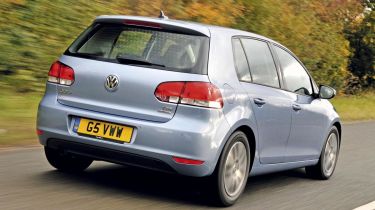VW Golf Bluemotion
Family favourite now gets even more green tweaks. But is there a compromise?

The previous Golf Bluemotion was a stop-start system away from being a five-star car - but now it really is the complete package. There’s no discernable sacrifices when it comes to car’s driving dynamics, equipment levels or looks, which is a stunning achievement when you consider it’s capable of returning almost 70mpg. And the level of refinement on the move, especially in a car this size, has to be experienced to be believed. An even more frugal, but less well equipped version will go on sale at the end of the year - but if you’re attached to your creature comforts the higher-spec SE driven here is the one to go for.
It’s the badge that launched a thousand eco-brands! VW was the first manufacturer to mark out its most efficient models under a separate banner with the Polo Bluemotion back in 2007. So with that extra experience under its belt can VW keep the most-efficient Golf one step ahead of the competition?
Beneath the cool-blue bonnet there’s an ultra-efficient 1.6-litre common rail diesel engine producing 104bhp and 250Nm of torque. But thanks to a subtle set of eco-tweaks this car can make a tank of fuel go even further.
Used - available now
Video: watch CarBuyer's video review of the VW Golf
[[{"type":"media","view_mode":"content_narrow","fid":"69241","attributes":{"alt":"","class":"media-image"}}]]
All the usual Bluemotion adjustments have been applied - including longer gear ratios, regenerative braking, a ride height dropped by 15 millimetres and low rolling resistance tyres. But the big news is the introduction of a stop-start system.
As a result, fuel economy has been stretched to 68.9mpg, a 6.1mpg improvement over its predecessor, while CO2 emssions have fallen by 12g/km to 107g/km. Despite this, the 0-62mph time of 11.3 seconds remains identical. However, the way it drives has changed dramatically.
Buying a low-emissions car has always been seen as something of a compromise - whether it be equipment levels, styling or refinement, something had to give. But a few minutes spent with the Golf is enough to realise that’s simply not the case anymore.
From the outside it looks as good, if not better than other standard models in the range. There’s no Focus ECOnetic-style wheel trims here - you get a gorgeous set of 16-inch alloys as standard. The suspension might have been lowered for aerodynamic reasons, but it also gives the car a sportier ground-hugging stance - and those shy of showing off their eco-purchase needn’t worry, the only branding is a subtle badge on the boot.
Climb inside and the cabin oozes quality that would put cars twice its price to shame. The soft touch-materials and feel of solidity is everywhere - and anyone that thought Bluemotion buyers have to sacrifice on kit can thing again.
This SE-spec model comes equipped with an iPod and MP3 connection, cruise control and air-con as standard. And our test car was loaded with such luxury options as a DVD touchscreen navigation system (£1,620), an automatic park assist function and a superb rear view camera.
Twist the key and even on bitterly cold mornings the engine starts smoothly and settles to a virtually silent idle. You’ll have to wait for the engine to warm through before the stop-start function begins to work, but when it does it’s unobtrusive and fool-proof.
Third, fourth and fifth gear have all been lengthened to keep engine revolutions to a minimum, but around town, where you mainly use the first two cogs, it feels just as fast and punchy as any other diesels in the range. And despite harder compound rubber in the tyres, refinement at speeds is exemplary. There’s also a sweetness to all the major controls that only a handful of cars, at any price, can match.
An even more economical version is on the way too. Based on the more basic S trim level, the newcomer will dip just under the magic 100g/km barrier, exempting it from road tax - but won’t arrive until the very end of the year.
The shot in the foot for the 107g/km model tested here is that two other non-Bluemotion models are also available with the same enginee tuned to 89bhp or 104bhp - both with CO2 emissions of 119g/km putting them in the same tax bracket as the eco-variant.
With the Bluemotion costing £410 more than the standard 104bhp model - it’s more of a lifestyle choice than a sound financial investment.
Rival: Ford Focus ECOnetic
The most-frugal Focus can’t match the Golf in terms of CO2 emissions or performance, but it’s just as good if not better in the bends. It’s also almost £2,000 cheaper in its most basic trim.







